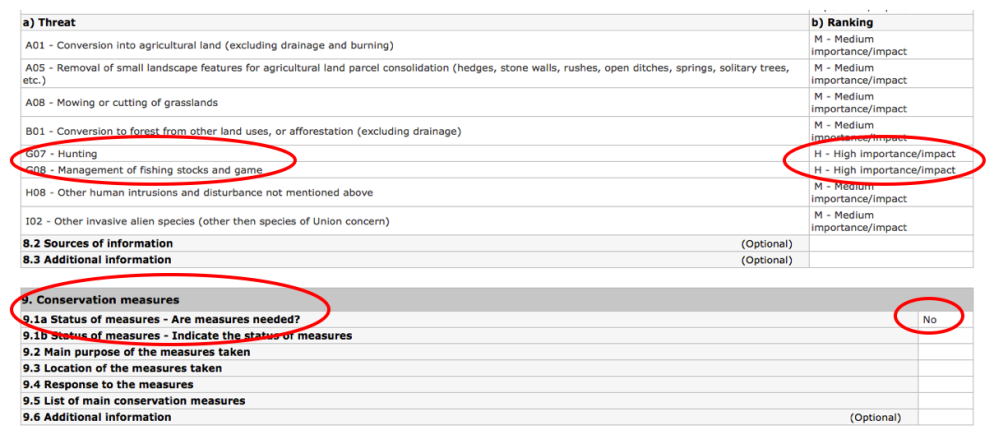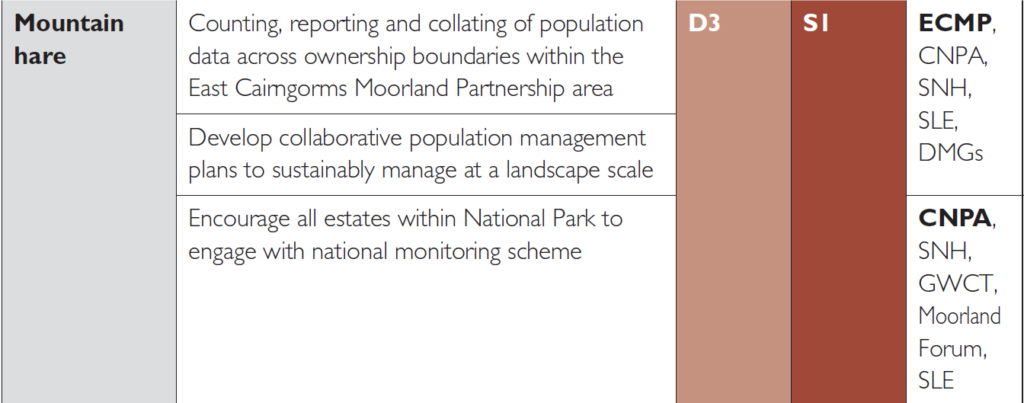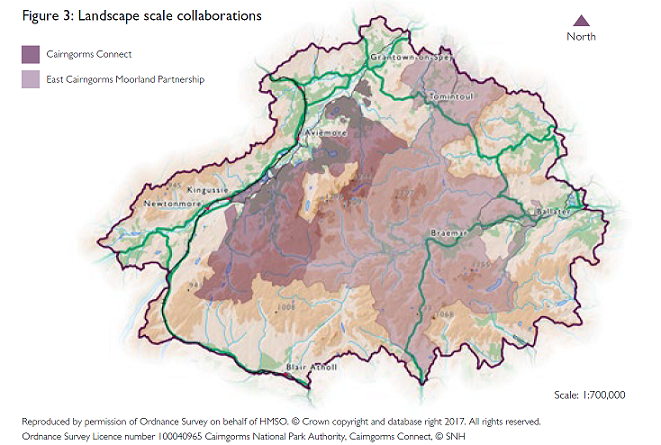[This post has been updated since publication to correct two erroneous claims, that not all of Balmoral is included in the East Cairngorms Moorland Partnership and that Delnadamph, owned by Prince Charles, was not a member of the partnership. See below].
The news that mountain hare numbers have collapsed in Scotland (see here for excellent analysis) should be cause for the Scottish Government, Scottish Natural Heritage and the Cairngorms National Park Authority to re-think why we still allow sporting estates and foresters to slaughter this species.
Unfortunately, along with the data they have supplied to the European Union SNH has also stated that no action is required:

The Scottish Government will no doubt use that as an excuse not to amend the Wildlife and Countryside Act which allows mountain hares to be killed without a license from the beginning of August to the end of February.
Our National Parks, however, have an independent statutory duty to conserve wildlife and have powers to do so. Parkswatch has now, for some time, been arguing that our National Parks could and should use their byelaw making powers to protect wildlife within their boundaries. Taking immediate action to protect the mountain hare in the Cairngorms, where historically there has been a high population of mountain hares and where much of the current slaughter takes place, would be a popular move. The general public expect wildlife to be better protected in our National Parks than elsewhere.
The Cairngorms National Park Authority avoided tackling the issue of how to better protect mountain hares in its Nature Action Plan (2019-24) which came into effect earlier this year. Although the plan identified the mountain hare as a priority species (along with its most important predator, apart from humans, the golden eagle) and that is was in decline, it put off taking any action to protect them until counting methodologies had improved and better data was available on their conservation status:

With the European Union now having published data showing that mountain hare numbers have collapsed, one might have hoped the CNPA would now have all the data they need to take action.
Perhaps, however, the number of hares within the East Cairngorms Moorland Partnership, which is the CNPA’s preferred mechanism to try and improve the way moorland in the National Park is managed, has bucked the national trend?

The East Cairngorms Moorland Partnership was set up as a voluntary collaboration between six named estates, Mar, Mar Lodge, Balmoral, Invercauld, Glen Avon and Glen Livet. (It also included Delnadamph, which is owned by Prince Charles, although this was not listed separately according to the CNPA as it is under the same management as Balmoral). Under the National Park Partnership Plan (2017-22) it was tasked with improving moorland management in the National Park (more mountain hares, more golden eagle and hen harriers, less muirburn etc). It covers a vast area and given its size, if hares numbers had been increasing within the area, one could reasonably have expect this to affect the national data. An exception perhaps to the rest of Scotland?
While I am not aware of the CNPA having published data on hare numbers from the ECMP estates – and I am pretty certain that the National Trust for Scotland at Mar Lodge will at least be trying to fulfil their commitment to count hares – information obtained by the Greens under FOI on licenses issued by SNH to kill mountain and brown hares out of season (see here) includes data from two of the estates:

What the data from the Greens shows is that Invercauld Estate killed 157 mountain hares OUT OF SEASON in 2018. If they killed that number in the close season, how many more were killed in the open season? It seems fairly safe to conclude from this that much of the ECMP area is not bucking the national trends and that hare numbers are collapsing there too. That should be a prompt to the CNPA to take action.
Both estates justified these new licenses on the grounds they were needed to protect new woodland – on conservation grounds if you like. There is no doubt that if you plant new woodland in a moorland desert, the number of herbivores – whether deer or hares – will explode locally as a result of the new food source. Indeed on the other side of the National Park, an area of new woodland was responsible for the greatest single hare cull out of season in Scotland (see here). The problem is increased many times over because our moorland areas have been turned into predator free grouse moors – on Invercauld the regular disappearance of raptors, which would help limit these local population explosions, is well documented (see here for example).
The answer to these issues does not lie in tinkering around the edges with the way grouse moors are managed as is happening in the East Cairngorms Moorland Partnership. Under the present grouse moor regimes, increasing the proportion of woodland – as the CNPA wants – will inevitably result in yet more wildlife slaughter, a contributory factor to the further decline in mountain hare rather than their protection.
Instead of trying to micro-manage land, what the Cairngorms National Park Authority should be doing is creating large areas where natural processes are allowed to follow their own course. Part of that means protecting mountain hares but also all the species that predate on them – including mammals such as foxes, stoats and weasels which are systematically persecuted through most of the National Park (the Cairngorms Connect Area being the exception). Its interesting, isn’t it, that in the areas where native woodland is generating most successfully, there is no mass culling of mountain hares?
What the CNPA needs to do
In order to fulfil its legal obligations to conserve wildlife, the CNPA should publish as soon as possible all the data that it has collected to date from the East Cairngorm Moorland Partnership, including that on the number of mountain hares. It should also publish how many other estates across the National Park are now co-operating with the national mountain hare monitoring scheme (see Nature Action Plan above). Unless it can show that the population of protected and half-protected species such as mountain hare have increased across all estates – and that includes Balmoral – within the ECMP area over the last two years, it should abandon the voluntary approach and initiate a consultation on how it can use its byelaw making powers to protect mountain hare and other wildlife across the National Park.
You are absolutely right, Nick, in what you say. There is growing scientific evidence from the Cairngorms Connect group of estates that allowing predator populations to increase is the way forward – NOT indiscriminate predator control by gamekeepers. The evidence being collected (with the involvement of Forestry Land Scotland) is that healthy, balanced predator populations do not result in dramatic reductions in their prey (e.g. capercaillie), as an increasing percentage of predator diet comes from them preying on other predators.
This evidence is on CNPA’s doorstep, but do they recognise this, or is CNPA just trying to be friends with all the major landowners, rather than doing its job? It’s long overdue for CNPA to step in and require the East Cairngorm Moorland Partnership to demonstrate with scientific evidence that it is actively trying to and succeeding in conserve wildlife (especially the predator populations), rather than finding ways of justifying its archaic ways of managing their lands to maximise grouse and deer populations.
Lastly SNH has become a ghost organisation which no longer stands up for Scotland’s Natural Heritage. The rot starts at the top with the Chairman, Dr Mike Cantlay OBE. He presided over some terrible years as Chairman of Visit Scotland, then having made a mess of that, got the job of Chairman of SNH, and what is the result……another mess.
Hi Gordon, To be fair to Mike Cantley the rot at SNH started well before his time and, in relation to the Cairngorms, I have to put my hand up to being involved in serious mistakes when I was on the SNH Board. We approved the de-declaration of a number of National Nature Reserves because landowners were refusing to put nature first when what we should have done is bypassed the civil servants, fully used the powers that SNH had in legislation (I am ashamed to say I did not know that some of the powers SNH had existed) and gone straight to the Scottish Parliament and asked them for their support. The whole system of course conspires against that but I was lucky enough to be on the SNH Board when there were a number of very critical thinkers – like Jim Hunter – and a far less controlling government and even so we missed the wood for the trees. One of my missions is to put some of those mistakes right. Nick
I take your point, Nick, and I appreciate your honesty. Like so many government appointments, it seems that it’s people that won’t rock the boat that get appointed to the top posts like Chairman of SNH. When I operated in the ‘corporate’ world, I always wanted some people in my team that would challenge what we were planning to do – even make me uncomfortable. This improved decision making and innovation. I get the feeling that there are just too many ‘yes’ people in Scottish Government circles.
Going back to this problem – the culling of mountain hares – Nicola Sturgeon seemed to say all the right things as a reaction to the BBC Countryfile exposure of mountain hare culling in January 2018. Clearly that was just to head off the criticism and make it appear that the Government was going to take action. A year and a half later, and in effect nothing has happened – yet another missed opportunity by the Scottish Government.